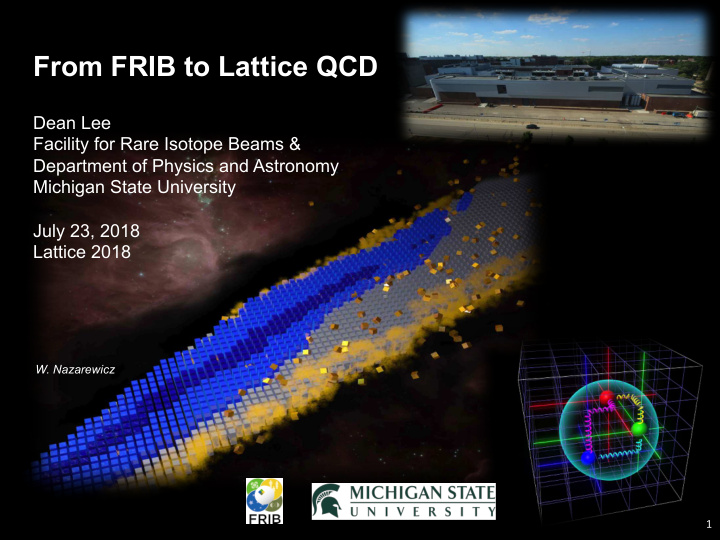



From FRIB to Lattice QCD Dean Lee Facility for Rare Isotope Beams & Department of Physics and Astronomy Michigan State University July 23, 2018 Lattice 2018 W. Nazarewicz 1
Outline Facility for Rare Isotope Beams Nuclear Landscape Astrophysical Processes Nuclear Forces Chiral Effective Field Theory Microscopic A -body Methods FRIB Opportunities for Lattice QCD Isotope Harvesting and Fundamental Symmetries Summary and Outlook 2
Facility for Rare Isotope Beams (FRIB) • A rare isotope facility has been a priority of the nuclear science community since the 1990’s • FRIB started in 2008 and will be a U.S. Department of Energy Office of Science scientific user facility for rare isotope research supporting the mission of the Nuclear Physics Program at the Office of Science • FRIB Project constructs a $730 million national user facility funded by the U.S. Department of Energy Office of Science, Michigan State University, and the State of Michigan • Planned completion date is June 2022, managing to early completion in 2021 T. Glasmacher 3
[FRIB Animation] 4
Nuclear Landscape N ~ 10 57 W. Nazarewicz 5
Nature 477, 15 (2011) 6
Astrophysical Processes 7
Half of the neutron-rich atomic nuclei heavier than iron are formed by the neutron-driven r-process. supernova abundance Nature 445, 58 (2007) neutron star mergers atomic number Au Dy Mon. Not. R. Astron. Soc. 430, 2585 (2013) W. Nazarewicz 8
GW170817 GravitaJonal wave signal observed by LIGO and Virgo detectors on 17 August 2017. Collision of two inspiraling neutron stars with a total mass of 2.82 solar masses. NASA/Dana Berry NASA / CXC / M.Weiss 9
The neutron star merger event is thought to result in a kilonova, characterized by a short gamma ray burst followed by a longer opJcal "aXerglow" powered by the radioacJve decay of heavy r-process nuclei. A total of 16,000 Jmes the mass of the Earth in heavy elements is believed to have formed, including approximately ten Earth masses in the elements gold and plaJnum. FRIB will give access to the extremely neutron-rich isotopes that have now been idenJfied to play a key role in explaining the observed kilonova. W. Nazarewicz 10
How were the elements made in the cosmos? How do the fundamental forces produce atomic nuclei? What is the nature of strongly-interacting matter? Can we find new physics beyond the Standard Model? With new science waiting to be discovered at the Facility for Rare Isotope Beams and the dawning of the era of exascale supercomputing, these questions present profound challenges and opportunities for nuclear theory. A good place to start is an overview of relevant energy scales and the principles of effective field theory. 11
Effective Field Theories and Energy Scales Lattice Quantum Chromodynamics Chiral Effective Field Theory Microscopic A -body Methods Configuration Interactions Density Functional Methods Mean Field Methods Effective Theory of Collective Modes W. Nazarewicz 12
Nuclear Forces 13
Nuclear Forces from Lattice QCD … and others 14
15
Chiral Effective Field Theory Weinberg, van Kolck, Epelbaum, Glöckle, Meißner, Krebs, Entem, Machleidt, ... 16
Microscopic A -body Methods Hergert, Yao, Morris, Parzuchowski, Bogner, Engel, Recent Progress in Many-Body Theories, June 25-30, 2017, APCTP, Pohang, Korea 17
Hergert, Phys. Scripta 92, 023002 (2017) 18
Need to reduce systematic errors Carlsson, et al., Phys. Rev. X 6, 011019 (2016) 19
Nuclear interactions are close to a quantum phase transition Elhatisari, et al., PRL 117, 132501 (2016) 20
Ekström, et al., PRC 91, 051301(R) (2015) 21
Using the NNLO sat interaction: Hagen et al., Nature Physics 12, 186-190 (2016) 22
A. Schwenk 23
24
How is it that pure neutron matter is not bound, but twenty protons are enough to bind as many as forty or fifty neutrons ? Is this a universal property of attractive fermionic systems or is there something special about the nuclear interactions? 25
FRIB Opportunities for Lattice QCD 26
For few-body systems, chiral effective field theory converges quickly for low-energy observables. Any reasonable choice of ultraviolet regulator is successful. Fit the two-nucleon forces to scattering phase shifts and three-nucleon forces to three-body properties. 27
For many-body systems, chiral effective field theory sometimes converges quickly, but sometimes not. There is some fine-tuning. Need more information about how nucleons interact with each other in the many-body environment and systematic errors produced by the ultraviolet regulator. Lattice QCD can address these unresolved questions. 28
Lattice calculations of few-nucleon systems at several different small volumes would be extremely useful. The volumes should be small enough to see non-universal effects [*] that depend on the range of the interaction. The periodic copies will mimic the effect of the many-body system, but with only a few particles. The calculations can be done at nonzero temperature and matched to lattice effective field theory calculations to extract three-nucleon forces and remove systematic errors in chiral effective field theory due to ultraviolet regulator effects. *For universal asymptotic finite-volume properties see König, D.L., PLB 779, 9 (2018) 29
Isotope Harvesting and Fundamental Symmetries Argonne NaJonal Laboratory 225 Ra is a good candidate electric dipole moment (EDM) searches as it has a relaJvely long half-life of 15 days, and has spin 1/2, which eliminates systemaJc effects due to electric quadrupole coupling. Also its nuclear octupole deformaJon enhances the atomic EDM by increasing the Schiff moment collecJvely and by the parity doubling of the energy levels. Z.-T. Lu 30
Z.-T. Lu 31
Z.-T. Lu 32
Summary and Outlook These are exciting times for nuclear physics. With new science waiting to be discovered at the Facility for Rare Isotope Beams and the era of exascale supercomputing, we have an opportunity to address big science questions. There are great opportunities for Lattice QCD to impact FRIB experiments through matching to chiral effective field theory and microscopic A -body methods. While there has been great progress in nuclear structure and reaction theory, there are open questions about first principles calculations of larger nuclei. Lattice QCD simulations can play a breakthrough role in solving these problems. 33
fribtheoryalliance.org 34
Recommend
More recommend